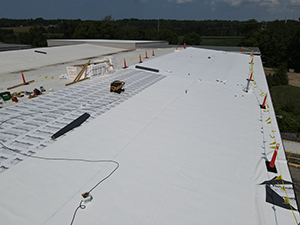
For commercial building owners, choosing the right roofing system is a crucial decision for long-term property protection and energy efficiency. Among the many options available, flat roofs remain a popular choice thanks to their cost-effectiveness, low maintenance requirements, and ability to accommodate HVAC units or solar panels. However, the performance of a flat roof depends largely on the quality of its installation. If you’re planning to install a new flat roof or replace an aging one, Brenneman Roofing in Ozark, MO is ready to help. Call (877) 370-6125 to speak with experienced professionals.
Basics of Flat Roof Installation
Flat roofs aren’t technically “flat”—they are designed with a very slight pitch (typically 1/4 inch per foot) to allow for proper drainage. Installation is a multi-step process that demands precision, technical knowledge, and weather consideration. Here’s a step-by-step overview of what commercial property owners should expect when installing a flat roof:
1. Preparation and Roof Deck Evaluation
The first step in flat roof installation is a thorough evaluation of the existing roof structure (if it’s a replacement) or the new deck (for new construction). This includes:
Assessing the substrate: Ensuring the deck is level, clean, and structurally sound.
Removing old roofing material: For replacements, all deteriorated or incompatible layers must be removed to prevent moisture entrapment.
Checking for slope and drainage: Drainage planning is essential to prevent ponding water, which is a common issue with flat roofs.
Proper preparation ensures the roofing membrane will adhere correctly and last its full life span.
2. Installation of Insulation Layer

Insulation is key for controlling indoor temperatures and enhancing energy efficiency. Common insulation materials for flat roofs include:
Polyisocyanurate (ISO): The most common and efficient type.
Extruded Polystyrene (XPS): Durable and moisture-resistant.
Expanded Polystyrene (EPS): Economical, though less moisture-resistant.
These layers are usually tapered to promote water runoff. They are mechanically fastened or adhered directly to the deck, depending on the system design and substrate material.
3. Vapor Barrier and Underlayment
In climates like Missouri’s, a vapor barrier is essential to prevent condensation buildup within the roof assembly. The vapor barrier layer is installed beneath the insulation and sealed to prevent moisture intrusion. An additional underlayment might be applied to serve as a bonding surface and improve membrane adherence.
4. Membrane Application
This is the most critical phase of a flat roof installation. There are several types of membranes used in commercial flat roofs:
TPO (Thermoplastic Polyolefin): Heat-welded seams, energy-efficient, and resistant to UV and chemical exposure.
EPDM (Ethylene Propylene Diene Monomer): A rubber membrane known for flexibility and durability.
PVC (Polyvinyl Chloride): High resistance to chemicals and fire, often used in restaurants or manufacturing facilities.
Membranes can be applied in three main ways:
Fully Adhered: Glued directly to the insulation.
Mechanically Fastened: Secured with screws and plates.
Ballasted: Held in place with gravel or pavers (less common today).
Each method has its own set of advantages and ideal applications. The membrane is installed in rolls with seams welded or adhered to form a waterproof seal.
5. Flashing and Edge Detail Work
Once the main membrane is in place, special attention is given to roof penetrations (vents, HVAC units, skylights) and perimeter edges. Flashing is installed to seal these vulnerable areas and prevent water infiltration. High-quality flashing ensures longevity and prevents leaks in the most stress-prone parts of the roof.
6. Drainage and Final Inspection
Before concluding the project, drains, scuppers, and gutters are installed or reconnected to channel water efficiently off the roof. A final inspection is conducted to check the membrane, seams, flashing, and overall workmanship. Often, a leak test is performed to ensure watertightness before handing over the roof for occupancy.
Flat Roof Experts
Flat roof installation is highly weather-sensitive, especially in areas like Ozark, MO, where humidity and storms can delay progress. The best times for installation are spring and fall, when temperatures are more moderate. Summer heat can interfere with adhesive curing, while winter conditions may affect membrane flexibility and proper sealing.
After installation, building owners should schedule routine inspections twice a year and following any major weather events. Keeping drains clear and documenting changes to the roof—such as new equipment—can help extend its lifespan and maintain warranty compliance.
When properly installed, a flat roof offers a reliable and efficient solution for commercial buildings. From material selection to drainage design, every step matters for long-term performance. If you’re ready to start your flat roofing project, don’t leave it to chance—call Brenneman Roofing in Ozark, MO at (877) 370-6125 for expert guidance and dependable service.
FAQ
How long does it take to install a commercial flat roof?
Installation time depends on the size and complexity of the building, but most projects take between 1 to 2 weeks under normal weather conditions.
What is the best flat roofing material for commercial buildings?
TPO and PVC are popular for their durability and energy efficiency. EPDM is also widely used for its flexibility and long lifespan. The best option depends on your building use, climate, and budget.
How do I know if my existing flat roof needs replacement or repair?
Signs include persistent leaks, ponding water, membrane shrinkage, or visible cracks. A professional inspection can determine the extent of the damage.
Can flat roofs support equipment like HVAC units or solar panels?
Yes, flat roofs are ideal for such installations. However, the structure must be assessed for weight capacity, and penetrations must be properly flashed and sealed.
Are flat roofs more prone to leaking?
Flat roofs are not inherently leak-prone if properly installed and maintained. Drainage design and regular inspections are key to avoiding issues.
